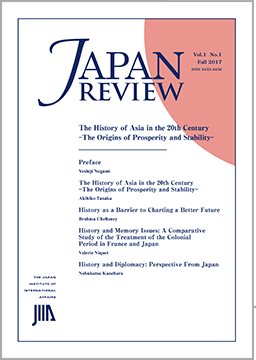Column/Report
|Top page|Print/Mobile page|Tweet
JIIA Strategic Comments(No.3):
A Look Back at the 2018 US Midterm Elections
Naoko Funatsu (Research Fellow)
The first midterm elections since the Trump administration took office were held on November 6, 2018, with the Republican Party maintaining a majority of seats in the Senate and the Democratic Party regaining a majority in the House of Representatives. Midterm elections are often called “a referendum on the sitting president” or “a midterm test of the incumbent president”, and these recent midterm elections merit attention in many regards.
■ The midterm elections as a “Trump election”
Particularly conspicuous in the recent midterm elections was the presence of the incumbent President Trump.
Voter turnout was 49.3%, an unusually high level for a midterm election. Voter turnout rates for most past midterm elections ranged from the high 30s to the low 40s, so the latest midterm elections garnered remarkably strong voter interest. A key reason was the presence of President Trump. One exit poll showed that 70% of people who had cast a ballot mentioned President Trump as a factor in their voting, and it is clear that President Trump provided an impetus for voting to both supporters and detractors in an increasingly divided American society.
America’s presidential system provides for checks and balances between the president and Congress as two of the three branches of government. Nevertheless, President Trump put himself forward as “the face of the Republican Party” and actively gave endorsement speeches for Republican congressional candidates, directly appealing to voters across the country with a message of “a vote for a Republican candidate is a vote for me.” In response, many Republican candidates sought to ride on President Trump’s coattails. A good example of this is Ted Cruz, a senator from Texas running for re-election who had been involved in a bitter fight with Trump during the 2016 Republican Party presidential primaries. With Cruz reported to be in a tight race, President Trump rushed to Texas to offer his support, and the speeches made by Cruz and Trump full of praise for each other made the war of words two years earlier seem a fiction; the fact that Senator Cruz ultimately emerged victorious from this tight race was symbolic. Also notable were candidates such as Ron DeSantis, winner of the gubernatorial race in Florida, who were known as “mini-Trumps” for their embrace of President Trump’s policies and style.
■ A growing “Trump coalition” within the Republican Party
What is the likely reason that “Trump-like” politicians have made headway in the Republican Party? It could be the fact that President Trump has solidified his support among the Christian conservative wing of the party. Since America’s founding, religion has never been completely separated from politics, and the leanings of Christian conservatives are important when considering the Republican Party as a conservative party. Abortion, same-sex marriage, and the protection/expansion of the rights of sexual minorities (LGBTQ) have become regular points of political contention splitting American society in two, and the religious beliefs of Christian conservatives allow them no leeway for compromise on these issues. Many of these divisive questions have been taken all the way to the Supreme Court for decisions, and Supreme Court rulings thus have great significance. Given that US Supreme Court judges have lifetime appointments until they voluntarily resign, the numerical balance between conservative and liberal judges on the nine-member court can have an impact on American society lasting for decades. Indeed, the fact that five of the nine Supreme Court justices are now conservative judges as a result of Neil Gorsuch and Brett Kavanagh, both conservatives nominated by President Trump, having taken office in April 2017 and October 2018 respectively can be attributed in great part to Christian conservative support for President Trump. While it is difficult to say that President Trump’s own words and deeds reflect the ideals of the Christian conservatives, the presence of Vice President Pence, a devout Christian believer, and the consolidation of Christian conservative support behind President Trump has bolstered what could be called a “Trump coalition” within the Republican Party over the past two years.
It is also worth noting that the number of moderate Republicans in the Senate has declined. Nine of the 35 Senate seats up for re-election in the recent midterms were Republican seats with two open due to the retirement of Bob Corker of Tennessee and Jeff Flake of Arizona, both moderates, as well as one change due to the death of John McCain of Arizona, which is a weighty factor when considering President Trump’s future political management. The absence of these moderate Republican senators, who frequently and openly criticized President Trump, will weaken the bulwark against Trump-like politicians in the Republican Party, and make it easier for President Trump to push his policies through a Republican Senate. President Trump’s style entails creating enemies and then methodically attacking those enemies to assert his own legitimacy and, with fewer Senate “enemies within,” he will find it easier to step up confrontation with House Democrats. As a consequence, he can be expected to label House Democrats enemies and scapegoat them as the cause of political gridlock.
■ No “Blue Wave” for Democrats produces a mixed victory
Democratic supporters had high expectations of a “Blue Wave” that would send a resounding “no” to President Trump, but the election results proved more of a disappointing “Blue Ripple” rather than “Blue Wave.” Although the party of the sitting president is said to be at a disadvantage during midterm elections, the Democrats failed to take control of the Senate, although they did regain the House of Representatives. Given that many of the candidates on the Democratic side were incumbents, who enjoy certain advantages in election campaigns, and that these House elections had a configuration favorable to the Democratic Party, the Democratic victory can hardly be described as a surging “Blue Wave”. The defeat of candidates seen as next-generation Democratic Party leaders whose liberal platforms garnered both expectations and attention highlighted the difficulty of setting an agenda in the increasingly polarized politics of modern America. Especially disappointing for Democratic supporters were the defeat of Beto O’Rourke, the new hope of the Democratic Party regarded as the second coming of President Obama, in a tight senatorial race against the incumbent Ted Cruz in Texas, part of the traditionally conservative South; the concession of Stacey Abrams, who had sought to become the first African-American woman to serve as governor of Georgia, another southern state; and the post-recount admission of defeat by Andrew Gillum, who had hoped to become the first African-American governor of the battleground state of Florida.
Looking at the bigger picture, however, gives one a perspective of a Democratic Party generating a new tide. The Democratic Party has traditionally been strong in cities with large numbers of highly-educated liberals and racial minorities, while the Republican Party tended to be favored in suburbs with many high-income earners seeking tax cuts and in rural areas populated by large numbers of Christian conservatives. The latest midterm elections produced numerous Democratic victories in suburbs such as Orange County, California, where Republican support had been rock-solid, due to larger numbers of votes from college-educated women, revealing seeds of change that cannot be discerned in the long-standing relationship between demographics and party affiliation. Democratic wins in both Senate and gubernatorial races in Wisconsin, Pennsylvania, and Michigan, former manufacturing hubs now part of the Midwest “Rust Belt” that emerged as battleground states during Donald Trump’s 2016 run for the presidency, must also not be overlooked; although these victories differed from earlier labor union-centered victories, they did indicate the potential for a Democratic rollback in the “Rust Belt” of battleground states that have a decisive impact on the outcome of presidential elections. The Democrats also did well in the 36 gubernatorial races that took place, with the Democrats picking up seven seats and the Republicans losing six, an especially important fact given that House districts will be redrawn based on the 2020 national census, and that governors in many states are authorized to approve the districting decisions of their state legislatures. Changing voting district boundaries in ways that use the residential distribution of voters to the advantage of one’s own party, a frequently criticized practice known as “gerrymandering”, will impact the course of future elections.
■ Future outlook and Japan-US relations
In light of the recent midterm results, what course is American politics likely to take from here on? To begin with, the Trump administration will undoubtedly find it difficult to pass several of its centerpiece policies in the face of opposition from a Democratic-majority House. More specifically, budget proposals for building a border wall with Mexico to control illegal immigration, expanding tax cuts to the middle class, and repealing the medical insurance system reforms passed in 2010 (“Obamacare”) will probably stall out. However, the bipartisan opposition to free trade agreements and support of trade protectionism that have become notable in recent years are expected to continue. Trump’s hardline policy toward China is unlikely to meet with opposition from House Democrats, and this approach will probably dominate not only trade but security and other areas as well, reflecting the sense of crisis now widely shared across party lines in the US as the reach of China’s power grows. Also anticipated are continued demands that the Japanese government work to reduce the US’ trade deficit with Japan. Unlike the 1980s, however, when Japan-US trade frictions were intense, public opinion polls now show that a majority of Americans (55%) regard Japan as a fair trading partner. Japan needs to assert the importance of free trade and persistently engage in negotiations. Using the bipartisan support for the Japan-US alliance in the US as a lever, Japan should continue playing a leading role in advancing the Indo-Pacific Initiative and contributing to regional stability by ensuring the US remains firmly committed to the region. (November 26, 2018)
(2018-11-26)
Topics
Membership
 Archive of high-quality scholary works translated from Japanese to English
Archive of high-quality scholary works translated from Japanese to English
A highlight of JIIA's recent activities and a summary of its organization.
Publication
Journal

Kokusai Mondai (International Affairs)
No.680 April 2019 "Protecting Human Rights via International Procedures"
Vol.2 No.4 Spring 2019
"Japan and the Post-World War II Liberal International Order"
Books
 What Do Alliances Mean to the US?
What Do Alliances Mean to the US?
(Fumiaki Kubo ed., 2013)






